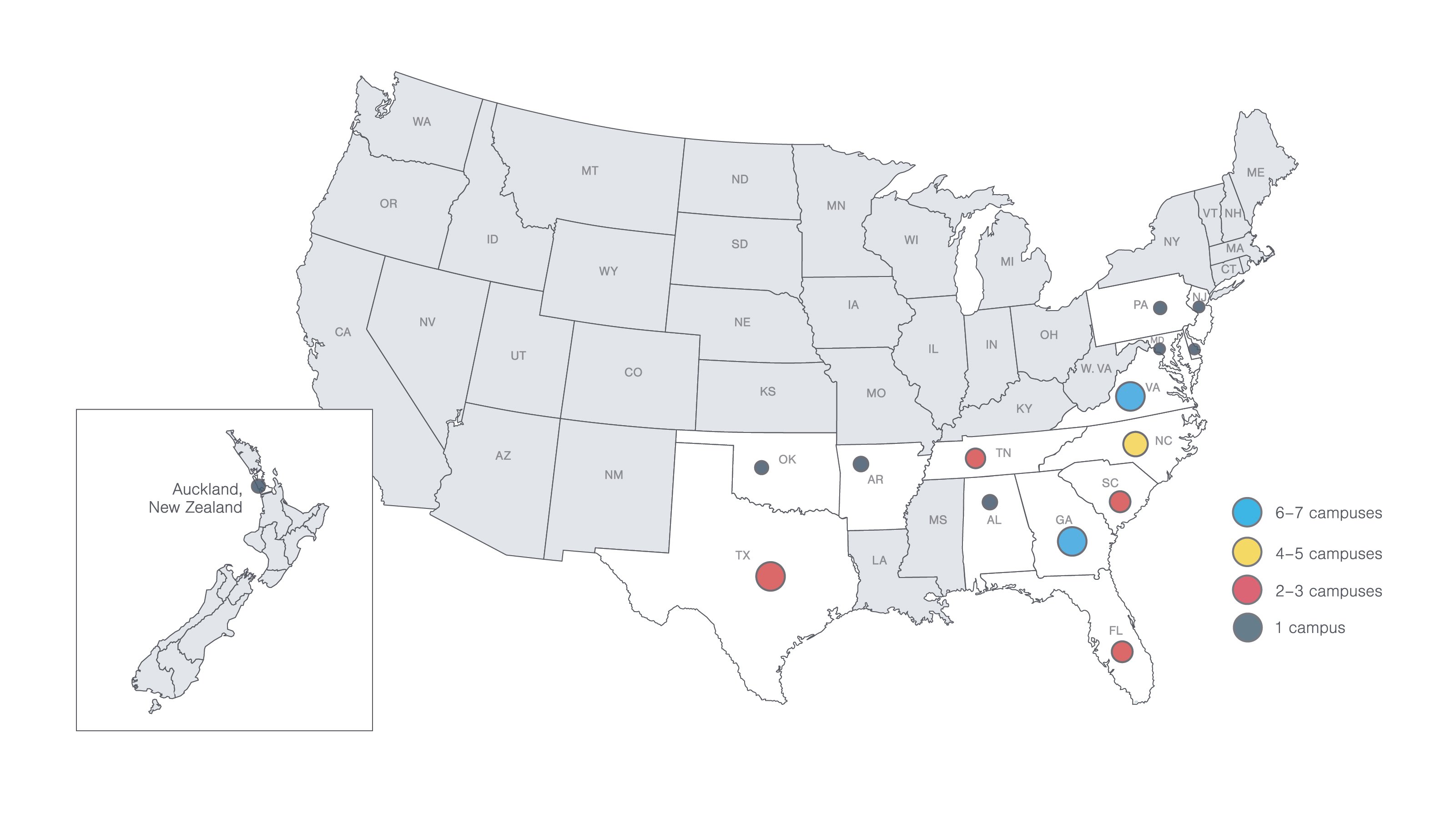Master of Educational Design and Technology Instructional Design and Technology
PROGRAM AT A GLANCE
This program is currently not approved for federal financial aid by the U.S. Department of Education (ED).
Why earn a Master of Educational Design and Technology, Instructional Design and Technology from Strayer?
Develop skills to support educators as they master new tools. When you complete this program, you’ll also earn a Graduate Certificate in Instructional Design and Technology.
Boost academic achievement using technology
Find out how to leverage technology to make learning more engaging and impactful. Strayer’s Master of Educational Design and Technology, Instructional Design and Technology examines the latest software, applications and other tech that can transform education and teaching methods. You’ll specialize in either K-12 or adult education, learning to design content that can lead to academic excellence.
Skills you’ll learn in a Strayer Master of Educational Design and Technology, Instructional Design and Technology concentration
A Strayer degree can help prepare you for career opportunities in instructional design and technology while offering support, flexible learning options and career planning every step of the way.
- Learn to design content to facilitate achievement of specific program and course outcomes.
- Explore instructional technology for either K-12 or adult education.
- Examine new technologies that have the potential to transform education.
- Design engaging learning experiences to include technologies that support learner engagement and success.
- Prioritize equality of access to technology based on access issues that may impact diverse students.
Earn your degree from an accredited university
Strayer University is an accredited institution and a member of the Middle States Commission on Higher Education (MSCHE or the Commission) www.msche.org. Strayer University’s accreditation status is Accreditation Reaffirmed. The Commission’s most recent action on the institution’s accreditation status on June 22, 2017 was to reaffirm accreditation. MSCHE is recognized by the U.S. Secretary of Education to conduct accreditation and pre-accreditation (candidate status) activities for institutions of higher education including distance, correspondence education, and direct assessment programs offered at those institutions. The Commission’s geographic area of accrediting activities is throughout the United States.

Completion of Strayer University’s Master of Educational Design and Technology program does not guarantee a student has met the requirements to apply for public school teacher or administrator licensure in any state, nor that a student will be eligible for pay raises, promotions or other job-related benefits. Students pursuing teacher or school administrator certification in the public school system should contact their respective state offices of education as well as local school district to confirm educational requirements before beginning the program. More information about state-specific requirements.
Master of Educational Design and Technology in Instructional Design and Technology cost breakdown
- 10 courses, $1680 per course
- $65 technology fee each term
- $150 one-time degree conferral fee
- Additional costs for textbooks and supplies
Estimate the cost of your degree
How much does a Master of Educational Design and Technology in Instructional Design and Technology cost?
Estimate the cost of your degree
How much does a Master of Educational Design and Technology in Instructional Design and Technology cost?
Expected Graduation
...
Approximate Total
...
*Student is required to take two courses per quarter during disbursement period
PREPARING YOUR RESULTS
Time commitment
Calculate the approximate time commitment of your degree.
| Course load | ... courses/term |
| Classroom time | ... hours/week |
| Terms per year | ... terms |
| Terms to graduation | ... terms |
Cost analysis
Calculate the approximate cost of your degree
| Tuition | ... |
| Books | ... |
| Fees | ... |
| No-cost gen ed | $0 |
| Transfer credits | ... |
| Transfer Credit Scholarship | $0 |
| $4K scholarship | $0 |
| Strayer Learn and Earn Scholarship | $0 |
| Approximate total | ... |
Ways to reduce tuition
$4K Alumni Master’s Scholarship
If you’re a Strayer University Alumni and ready to pursue a master’s degree, our Alumni Scholarship can save you $4,000. All you need to do is register for an eligible Strayer graduate program, maintain a GPA of 2.5 or greater and meet eligibility requirements.
50% off Master’s Scholarship
Enroll in two master’s courses, get 50% off tuition.
*Eligibility rules, restrictions and exclusions apply.
Civic and Community Alliance Scholarship
Ready to earn an affordable Strayer degree? Admitted Strayer or JWMI students who are employed in certain civic roles or volunteer for a nonprofit may be eligible to receive 25% off tuition for the duration of their program.
Explore courses in Strayer’s Master of Educational Design and Technology, Instructional Design and Technology
Discover how you can use technology to make lessons and curriculum more engaging for students in K-12 or higher education. In this concentration, you’ll learn to evaluate educational technology for its relevance and integrate it appropriately to enhance learning experiences. The curriculum examines how innovative technologies can support alternative teaching approaches, helping to meet the unique needs of individual students.
Instructional Design and Technology concentration courses
Complete your degree from where you live, on your time, in a flexible, 100% online program. Using our online portal, you’ll be able to:
- Access lectures and coursework
- Complete assignments and exams
- Communicate with professors and classmates
- Access student resources and support
From day one, you’ll have a team of advisors and coaches to help you balance college, work and your personal life. Tap into support resources online or at a campus near you.
You’ll have access to:
- Admissions and enrollment support
- One-on-one academic coaches
- Financial guidance and potential cost savings
- Career planning services
The faculty at Strayer University bring years of real-world experience to the classroom, offering valuable insight and practical knowledge. They are committed to supporting your professional goals and are responsive to questions and concerns through the virtual courseroom.
What can you do with a Master of Educational Design and Technology, Instructional Design and Technology degree?
Your education can help you pursue your professional and personal goals. While Strayer cannot guarantee that a graduate will secure any specific career outcome, such as a job title, promotion or salary increase, we encourage you to explore the potential impact you can have in the education field.
Versatile skills for your future
The instructional design and technology concentration can provide the skills to help you create courses and materials designed to improve students’ learning experiences.
In addition, students who complete this concentration will be prepared to:
- Evaluate teaching performances and suggest ways to improve teaching skills.
- Create recommendations on curricula, teaching methods and materials for school systems.
- Recognize different types of learners and adjust course content or delivery to meet their needs.
- Determine how effective instructional systems, courses or educational materials are based off performance data.
- Assess instruction efficiency and effectiveness based on the ease of using instructional technology, student learning outcomes and satisfaction.
- Perform needs assessments and strategic learning assessments to help you develop or update curricula.
- Develop instructional aids for classroom and online settings.
- Create comprehensive course documentation that meets accreditation, certification or other requirements.
- Create assessment tools to measure the effectiveness of instructional or training interventions.
- Update instructional materials, including lesson plans, instructor guides and tests.
- Suggest ways to improve curricula or delivery methods using instructional effectiveness data, performance requirements, feasibility and costs.
86
of Strayer master's alumni agree that Strayer was the right choice for earning their degree.
Strayer Alumni Survey, 2023
Apply for your Instructional Design and Technology degree today
An admissions officer can help you choose the right program, register for classes, transfer credits and find cost-savings opportunities.
Here’s what you’ll need to get started:
Winter classes start on January 5
Learn more about Strayer University’s admissions process.
Transferring to Strayer from another university?
Transfer up to four eligible classes from a prior college or university to your master’s degree, saving time and money.
Strayer welcomes international students
Strayer University is proud to have hosted more than 4,000 international students from over 143 countries. Earn your degree in the U.S. or completely online in your home country – it’s your choice.


Campus locations
Come to a campus near you for guidance and support. You’ll have access to helpful resources, a supportive community and plenty of spaces to learn and grow.
This program is currently not approved for federal financial aid by the U.S. Department of Education (ED).
Ready to take the next step?
Your admissions officer is here to guide you through every step of the process, from completing your application to choosing your concentration.